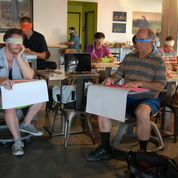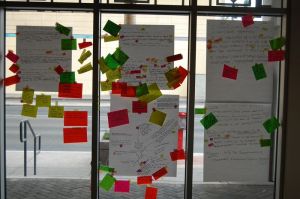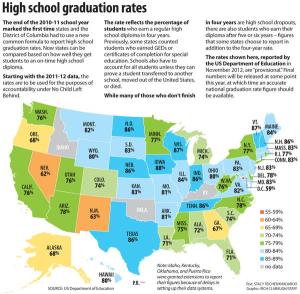Peter Aguero of The Moth visited with us and shared the power of story. We all need to be able to frame a powerful and captivating story if we want to engage others in our work.
With every story, he encourages us to tell about: What happened? How did you feel? Why?
Stories about change are effective, as are stories about pinnacle events, e.g., the worst Christmas, the best kiss. He encourages storytellers to expose their own vulnerabilities, which in turn helps others to share theirs, leading to mutual strength.
Rachel was reminded of the work of Maxine Greene on the social imagination — stories allow us to cross barriers. I was reminded of a recent interview with David Isay, the creator of StoryCorps. So many people, he says, have reported that the 40+ minutes they spend in a StoryCorps booth being interviewed by a loved one have been among the most powerful experiences of their lives. Isay dissects why this is – the power of telling our story and also the power of listening. And Tom shared an example of storytelling with students — The Iowa Narrative’s Project in which students produce 8-minute podcasts.
Circling
After lunch, we circled around for a strenuous, complex, and generous conversation about what might be next. What common ground have we established? What ideas, big and small, were birthed?
Not surprisingly given the large number of sticky notes surrounding ideas around the current structure of higher education, we started by talking about the tenure system – what’s broken, what’s working. Given the focus on social entrepreneurship the Institute, we quickly wondered about how business is effecting education for ill (Michael gave the example of his students registering for a course and it goes in a shopping cart) and for good (Jessica gave an example of “cash cows and loss leaders” – the loss leaders that support a department’s or institution’s mission get to stay, those that don’t need to be cut).
Question: Is it possible to figure out what the metric is for social impact in higher education?
We wondered about each institution’s strategic plans (a few of us were able to quote directly from them – kudos Chuck, Bo, and Ken!). How do we clearly align whatever we do next with these in order to make a case for institutional funding?
We were very focused on what we can borrow from social entrepreneurs, but what does higher ed have to offer them? Beth commented that the depth of knowledge that the humanities, in particular, provide for understanding the past provides perspective and humility in how you deal with the present and future.
Eli: Why would you come back together again? What is chapter 2? Continually ask, ‘Why?’
Group: Because we see that the system is not working.
If we want to be accountable for what we profess, we need to bring in more of our peers and share this with them.
Eli: Why would a Tony Hsieh talk to you? What do you have to offer him?
Group: We have access to Millennials. We’re independent; we can provide evaluative services that are objective. We also offer an abundance of brainpower: UNLV has 900 experts in its faculty alone, plus graduate students. All of these minds can be brought to bear on specific issues.
Kate: What if we rebrand the university?
There was conversation about what this means, including Dave sharing the two blue-sky ideas from the night before:
A) The Trading Places metaphor in which a creative, such as Eli, is traded for a faculty member; the entrepreneurial space gains someone who can provide deep knowledge and training in a specific area of pertinence to their work, and the university gains someone who can provide new tools and methodologies.
B) The two-week ideal university that pops up during Winterim or maybe in conjunction with Life Is Beautiful – may include actual credits and funding sources for the home institutions; could move from place to place or stay in LV; the city as text; provides faculty to come and try classes and collaborations that they can’t do at home. [Modeled on something like a Iowa Summer’s Writing Festival?] These could be solution based.
“LET’S STOP TEACHING SUBJECTS AND START TEACHING SOLUTIONS.”
We need to build a container. What is our container?
Dave recommended TRIBAL LEADERSHIP – about the notion of forming tribes. The highest level is when a group of people are gathered and focused on something bigger than themselves.
We shared some examples of project-based learning:
Tom shared a NY Times Op Ed about breaking apart the current university system: http://www.nytimes.com/2009/04/27/opinion/27taylor.html?pagewanted=all&_r=0
problem / purpose / process
This is what we want to share – Examining a problem and doing so with purpose that extends beyond our research to the wider community, via a creative and collaborative process.
Ken asked: “Place, purpose and pedagogy – which one comes first, which one is leading what we do?”
Here is what we agreed on:
- The desire to re-brand the university.
- That business can inform the university and the university can inform business.
- That we want to work on big social problems.
The next steps? Write your chapter, friends!


















